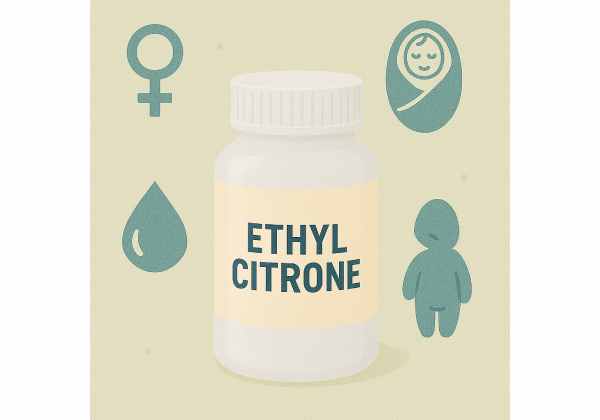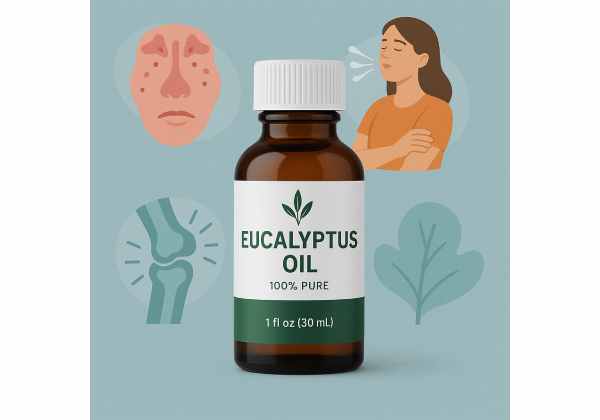Ethisterone Explained: Progestin Therapy, Health Effects, and Modern Alternatives
Ethisterone is a first-generation, orally active progestin developed in the mid-20th century. As a synthetic agonist of the progesterone receptor, it can stabilize the endometrium, reduce bleeding, and oppose unopposed estrogen in the uterus. Historically, it was tried for recurrent miscarriage and abnormal uterine bleeding, sometimes combined with diethylstilbestrol (DES). Over time, newer progestins and micronized progesterone largely replaced...
Ethyl citrate Explained: Food Additive Uses, Supplement Properties, and Dosing
Ethyl citrate is most commonly encountered as triethyl citrate, the tri-ester of citric acid formed with ethanol. You’ll see it on cosmetic labels and in regulatory texts under that precise name. It is a colorless, nearly odorless liquid valued as a solvent, plasticizer, and processing aid. In consumer products, triethyl citrate appears in many deodorants where it helps curb...
Ethyl gallate Supplement Guide: Antioxidant Properties, Health Benefits, and Safety
Ethyl gallate is a plant-derived polyphenol best known as the ethyl ester of gallic acid. In the lab, it is valued for strong antioxidant and antimicrobial actions; in product development, it is explored as a stabilizer and skin-soothing adjunct. Early research also points to anti-inflammatory and cytoprotective effects in models of liver injury, wound repair, oral biofilms, and neurodegeneration....
Ethyl nicotinate: Top Uses, Benefits, Dosage Guidelines, and Side Effects
Ethyl nicotinate is a small, fast-acting ester of niacin used mainly in topical products to increase skin blood flow. In warming creams, balms, and certain cosmetic preparations, it produces a brief flush and heat sensation by dilating tiny vessels in the skin. Researchers also use it as a standardized “provocation” agent to test microcirculation and to benchmark devices that...
Ethyl Pyruvate: Top Health Benefits, Mechanisms, Dosage, and Safety Guide
Ethyl pyruvate is the ethyl ester of pyruvic acid—the small, central metabolite that sits at the crossroads of glycolysis and the Krebs cycle. By esterifying pyruvic acid, chemists created a more lipophilic, shelf-stable molecule that can cross cell membranes more easily and resist rapid breakdown in water. In laboratories and early clinical settings, ethyl pyruvate has been explored as...
Ethyl vanillate Supplement: Antioxidant Properties, Health Applications, and Dosage
Ethyl vanillate is the ethyl ester of vanillic acid—the familiar aromatic building block behind vanilla-like notes in food and fragrance. Beyond its sensory appeal, this phenolic compound has drawn scientific interest for antioxidant behavior and potential roles in skin care. You will also see it listed on the European Union’s register of permitted food flavourings, which sets a regulatory...
Ethylenediaminetetraacetic acid (EDTA): Heavy Metal Detox, Heart Health, and Safe Supplementation
Ethylenediaminetetraacetic acid (EDTA) is a widely used chelating agent that binds “hard” metal ions such as lead, calcium, and cadmium. In medicine, its best-supported use is the treatment of confirmed lead poisoning with the calcium disodium salt (edetate calcium disodium). The disodium form (edetate disodium) is different: it lowers serum calcium and is reserved for specific emergencies like severe...
Ethynodiol diacetate Birth Control: Uses, Effectiveness, and Safety Insights
Ethynodiol diacetate is a classic progestin used in combined oral contraceptive (COC) tablets together with ethinyl estradiol. While newer formulations crowd today’s shelves, ethynodiol diacetate remains a practical option in 21/7 regimens such as Kelnor and Zovia. Like other COCs, it prevents pregnancy primarily by suppressing ovulation, while also thickening cervical mucus and keeping the endometrium thin and less...
Etidronic acid for Osteoporosis: Evidence-Based Benefits, Dosing, and Safety
Etidronic acid—often called etidronate—is a first-generation bisphosphonate used for specific bone conditions. Unlike newer agents, etidronate’s value is highly focused: it can help control the high bone turnover of Paget’s disease of bone and is approved to prevent heterotopic ossification (HO) after total hip replacement or spinal cord injury. Its chemistry gives it a strong affinity for bone mineral,...
Etonogestrel Implant: Long-Acting Contraceptive Benefits, Dosage, and Risks
Etonogestrel is a progestin used in two popular contraceptive options: a single-rod subdermal implant and a combined hormonal vaginal ring (with ethinyl estradiol). As a contraceptive, etonogestrel primarily prevents ovulation while also thickening cervical mucus and thinning the endometrium to reduce the chance of pregnancy. The implant offers years of low-maintenance protection with rapid return to fertility after removal;...
Eucalyptol Benefits: Complete Guide to Respiratory Relief, Safety, and Dosage
Eucalyptol, also called 1,8-cineole, is the minty-camphor aromatic molecule that gives eucalyptus its signature scent. Beyond fragrance, it has measurable biological actions relevant to coughs and colds: thinning thick mucus, modulating inflammatory signals, and creating a cooling sensation that can make breathing feel easier. In Europe, standardized eucalyptol capsules are used as short-term adjuncts for upper-respiratory symptoms. That is...
Eucalyptus oil: Natural Respiratory Remedy, Pain Relief, Uses, and Safety Overview
Eucalyptus oil has a clean, camphor-like aroma and a long history in over-the-counter balms and inhalants. Its main active molecule, 1,8-cineole (also called eucalyptol), has been studied for effects on mucus, inflammation, and cough. People reach for eucalyptus oil to help breathe more comfortably with colds, soothe tight muscles, or freshen indoor air. But results depend on how you...
Eucheuma cottonii: Sea Moss Benefits, Uses, Supplements, and Risks Explained
Eucheuma cottonii—now widely cultivated under the scientific name Kappaphycus alvarezii—is a red tropical seaweed best known as a natural source of kappa-carrageenan, a gelling and thickening fiber used in foods and supplements. As a whole food, it contributes soluble fiber and minerals, and it forms the base of many “sea moss” gels sold for digestive and culinary use. Interest...
Eucommia bark: Joint Health, Blood Pressure, Adaptogen Uses, and Safe Dosage
Eucommia bark—known in Traditional Chinese Medicine (TCM) as Du Zhong (from the tree Eucommia ulmoides)—has been used for centuries to support the lower back and knees, nourish “liver and kidney,” and help with healthy blood pressure. Modern research is beginning to map these traditional claims onto measurable mechanisms: vascular relaxation, nitric-oxide signaling, anti-inflammatory actions, and effects on connective tissue...
Eugenia jambolana: Top Benefits, Diabetes Support, Dosage, and Side Effects
Eugenia jambolana—better known as jamun, java plum, or Syzygium cumini—is a deep-purple fruit long used in traditional systems of medicine across South Asia. Modern interest focuses on its dense polyphenol content (notably ellagitannins and anthocyanins), its seed’s role in glucose metabolism, and its versatile food uses from fresh fruit to powders and extracts. While laboratory and animal studies suggest...
Eugenol: Pain Relief, Oral Health, and Natural Antioxidant Benefits
Eugenol is the aromatic compound that gives cloves their warm, spicy scent—and many of their traditional uses. Found primarily in clove buds (Syzygium aromaticum), it also occurs in cinnamon, bay, nutmeg, and basil. In modern practice, eugenol shows up in dental materials, flavorings, topical preparations, and research on inflammation and microbes. People often reach for clove oil (rich in...




















